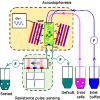当前位置:
X-MOL 学术
›
Phys. Rev. Appl.
›
论文详情
Our official English website, www.x-mol.net, welcomes your
feedback! (Note: you will need to create a separate account there.)
Mechanical Characterization of Cells and Microspheres Sorted by Acoustophoresis with In-Line Resistive Pulse Sensing
Physical Review Applied ( IF 3.8 ) Pub Date : 2020-03-24 , DOI: 10.1103/physrevapplied.13.034058 Antoine Riaud , Wei Wang , Anh L.P. Thai , Valerie Taly
Physical Review Applied ( IF 3.8 ) Pub Date : 2020-03-24 , DOI: 10.1103/physrevapplied.13.034058 Antoine Riaud , Wei Wang , Anh L.P. Thai , Valerie Taly

|
Resistive pulse sensing (RPS) is a key label-free technology to measure particles and single-cell size distribution. As a growing corpus of evidence supports that cancer cells exhibit distinct mechanical phenotypes from healthy cells, expanding the method from size to mechanical sensing could represent a pertinent and innovative tool for cancer research. In this paper, we infer the cells’ compressibility by using acoustic radiation pressure to deflect flowing cells in a microchannel, and use RPS to sense the subpopulations of cells and particles at each acoustic power level. Compared to current acoustic cell phenotyping apparatus based on video cameras, the proposed approach is not limited by optical diffraction, frame rate, data storage, or processing speed, and may ultimately constitute a step forward towards point-of-care acousto-electrical phenotyping and acoustic phenotyping of liquid biosamples.
中文翻译:

机械和表征的细胞和微球的在线电泳与电阻式脉冲传感排序。
电阻脉冲感测(RPS)是一种无标签的关键技术,可用于测量颗粒和单细胞尺寸分布。随着越来越多的证据支持癌细胞表现出与健康细胞不同的机械表型,将方法从大小扩展到机械感测可能代表了癌症研究的相关创新工具。在本文中,我们通过使用声辐射压力来偏转微通道中流动的细胞来推断细胞的可压缩性,并使用RPS来感测每个声功率水平下的细胞和颗粒亚群。与目前基于摄像机的声细胞表型分析设备相比,该方法不受光学衍射,帧频,数据存储或处理速度的限制,
更新日期:2020-03-26
中文翻译:

机械和表征的细胞和微球的在线电泳与电阻式脉冲传感排序。
电阻脉冲感测(RPS)是一种无标签的关键技术,可用于测量颗粒和单细胞尺寸分布。随着越来越多的证据支持癌细胞表现出与健康细胞不同的机械表型,将方法从大小扩展到机械感测可能代表了癌症研究的相关创新工具。在本文中,我们通过使用声辐射压力来偏转微通道中流动的细胞来推断细胞的可压缩性,并使用RPS来感测每个声功率水平下的细胞和颗粒亚群。与目前基于摄像机的声细胞表型分析设备相比,该方法不受光学衍射,帧频,数据存储或处理速度的限制,









































 京公网安备 11010802027423号
京公网安备 11010802027423号